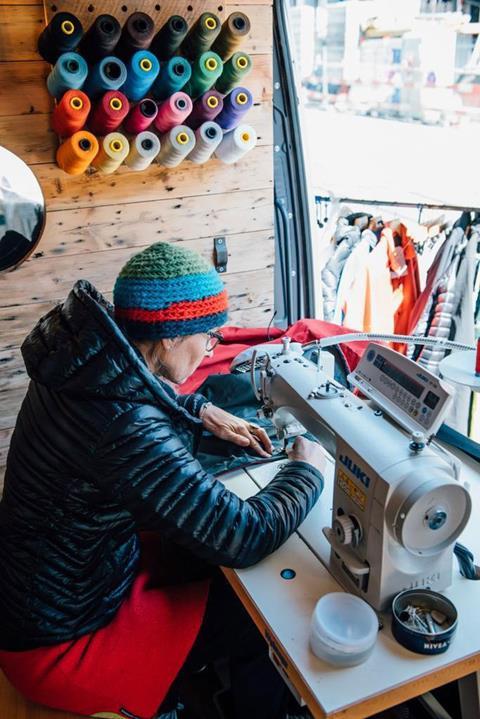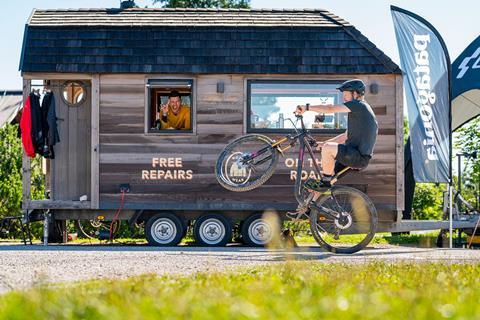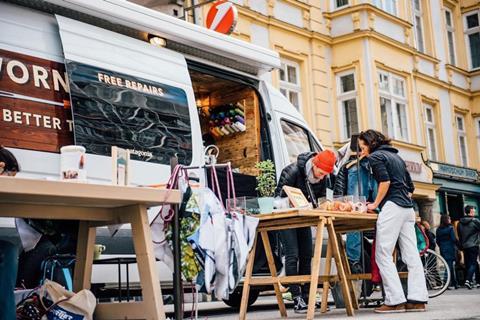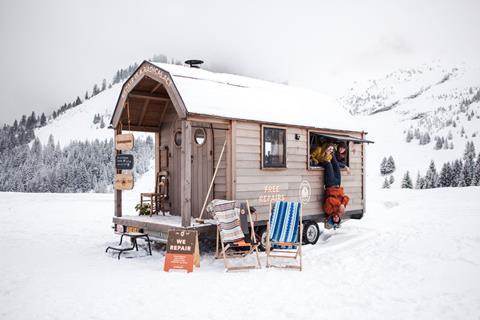Patagonia is often held up as being one of the most sustainable brands in the Outdoor and Sporting industry (although the brand itself may reject the use of the word “sustainable,” acknowledging that everything it makes has an impact on the planet). What is for certain is that Patagonia is an example of Re:Thinking Business: Closing the loop and acting more responsibly with practices like reduce, repair, resale and recycle.
For our Re:Thinking Business special edition, we checked exactly how far Patagonia has come in closing the loop and making circularity an integral part of their product lifecycle. What we found? Patagonia can already rely on experience and numbers that show how far they’ve come, but even for the pioneers, there is one part in the circularity system where Patagonia has made only small steps.
On a sunny afternoon in Munich we sat down with Birgit Grossmann, Community Marketing and Impact Manager Central Europe at Patagonia, who provided us with all the insights and numbers we need for a closer look.
Circularity begins with design. How well does Patagonia design for longevity and repair?
Basically, Patagonia’s goal is to design products so that they are repairable and only have pockets, seams, prints, and so on that are necessary for the intended use.

“For example, the designers think very carefully about what might break first. So quite often it’s the zippers that are the weak points on the product,” says Grossmann. “So then the first decision is whether it really needs that particular zipper.”
As such, in addition to using responsible and durable materials, Patagonia also aims to extend the life of a product by deliberately omitting non-functional elements.
How does Patagonia help “reduce”?
Few could have missed Patagonia’s 2011 “Don’t Buy This Jacket” campaign. Grossmann, though, is keen to point out that there are many Patagonia campaigns that call on consumers to buy less and to think carefully about what they are buying and why.
A lot of the brand’s storytelling also deals with reuse and repair. “All of this pays off in terms of producing less,” says Grossmann. “The better we set up our cycles overall, the less new production is needed. Of course, that doesn’t work overnight.”
How does Patagonia help with “repair”?
Patagonia’s responsible business model has included repair for decades. Repair for Patagonia products was introduced back in the 1970s and as a general rule, repair is always free for Patagonia products. In some countries, including the U.S., Patagonia even has its own repair shops.
But the brand wants to make repair the norm once more, especially in technical clothing. In 2005, the Worn Wear Program was launched, and with it stories of repaired garments could be used to boost the idea of repair via marketing.
Globally, Patagonia now has 72 repair centers and repaired over 100,000 products in the past year. 13 of the centers are in Europe and are jointly operated with partners. Patagonia’s declared goal is to increase the number of repairs in the coming years, even if this means increased costs for the company: “This is part of Patagonia’s mission to save our home planet,” says Großman.
Repairing Patagonia gear in Europe
A common sight in Europe are the familiar Worn Wear repair vehicles. The unmistakable vintage caravan, tiny house and van are paid for out of the marketing budget: “Repair in itself isn’t a profitable business, but it’s part of Patagonia’s commitment to quality and longevity that supports the business in the long run” explains Großman, bringing the idea and viability of repair to more people.
The campaign from Patagonia started in 2016 with two traveling tailor workshops. There are now three Worn Wear repair vehicles and a fourth is being built. If necessary, a fifth vehicle will follow soon.
There is no shortage of staff. Although repairing functional clothing is a special task, Grossmann explains that the company has been able to recruit highly motivated freelancers with a great deal of experience in repairing functional clothing.
On tour, they also repair garments from other companies, also free of charge: “Because otherwise we can’t change anything on a large scale.”
Not a subscriber yet?
Dive deeper into the sporting goods industry with the latest insights and stories – straight to your inbox!
Permanent tailors now work in the flagship stores in Berlin and Milan. In addition, end customers can print out a return label on the Patagonia homepage and send in Patagonia clothing for repair. Clothing can also be returned to retailers. These are then sent for repair and returned to the respective retailer.
When it comes to the repairs themselves, one of the biggest challenges is keeping the clothes clean. “Unwashed garments are a problem, for one thing, because the tailors of course work closely with garments and that can be uncomfortable. But also, unwashed functional clothing often can’t be repaired well as a result,” Grossmann says. For example, if there is a lot of sweat on waterproof jackets, then the salt means membranes can no longer be taped well.
A second challenge is staff resources over time. There are always phases in the Berlin store, for example, when a lot of people want to get their things back into working shape, and phases when the repair service is used less.
Overall, Grossmann believes the popularity of the repair service is increasing. She believes there is a change in thinking in society. Six years ago, many customers came and wanted to have their clothes repaired as perfectly (and discreetly) as possible. In the meantime, she says, many customers come in and are happy to receive “obvious” patches. “There are more and more people who come and say, ‘It’s cool to see that I’ve already experienced something with my climbing pants’.”

Does Patagonia do rental?
When we’re talking about the circular economy, rental is an area which is not yet very developed at Patagonia. However, the first pilot projects are underway.
Does Patagonia do resale?
In Europe, Patagonia started a pilot program for secondhand clothing in the fall of 2022. “There is a big difference at Patagonia between the U.S. and Europe,” Grossmann says. The European pilot is currently running at the Berlin store, where used Patagonia clothing is sold. The selection is made up of returns and merchandise that has been returned locally in Berlin or collected at the repair center in Amsterdam.
Unlike the repair sector, Patagonia’s reuse and resale sector has to finance itself. But the project is well received, says Patagonia’s Marketing Manager. The biggest challenge is sourcing the clothing: “It’s difficult to get clothing out of people’s closets that is actually just hanging around.”
In the U.S., Grossmann says, the secondhand business is already more established, with 30 percent growth from 2020–21. “That’s accumulated about 33,015 kilos of clothes. Clothes that didn’t end up in the landfill, but were kept in circulation.”
When it comes to pricing in the Berlin store, Patagonia benefits from its experience in the U.S.. In the German store, there are “28 price categories. The classification is very differentiated, and we look extremely closely at what defects a garment may have, what exactly has been repaired, and of course whether it is almost new or has been worn for some time,” explains Grossmann.

How well does Patagonia recycle?
In terms of its use of recycled materials, Patagonia’s goal is to switch completely to the use of recycled materials. In its own words, Patagonia states, “We’re planning to stop sourcing virgin petroleum for products and instead use preferred materials by 2025, including organic and regenerative organic cotton, recycled polyester and recycled nylon, among others.”
As it stands, by weight, currently 80 percent of raw materials used by Patagonia are made from recycled materials and another 10 percent from renewable materials. For high-performance products used in extreme conditions, synthetic fibers are used to ensure longevity and durability. 98 percent of the current collection is made from recycled materials.
But recycling is a two-pronged element in the circular system. Not only using recycled materials but also manufacturing garments that can themselves be recycled at end-of-life. And of course, facilitating this by encouraging consumers to dispose of textiles responsibly.
A big hurdle is closing the loop with the help of customers and encouraging them to return their old clothes that can no longer be repaired. But here, too, Grossmann sees a change in thinking: “We are noticing that customers want to use their clothes longer, and come to our shop and have things repaired. However, many things can no longer be repaired and then of course the willingness to recycle the garment is 100 percent there.”
In the end, the circular system really is a circle, with each aspect feeding into the next. As Grossmann concludes: “I think the repair theme promotes the recycling theme.”
-> Enjoyed this article? Find more of our circular economy content in our Re:Thinking Business special edition.








